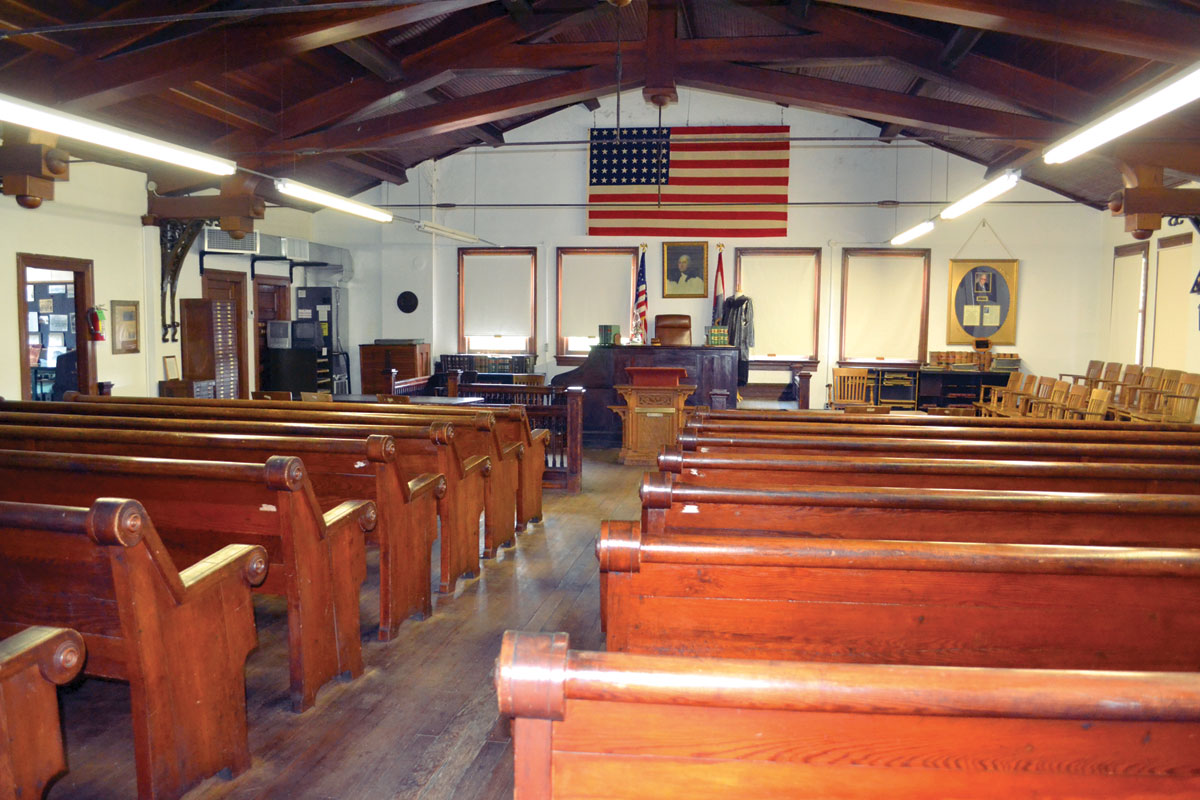
Former courthouse in Pulaski County, Mo., now serves as a museum for local artifacts
Pulaski County is home to one of two remaining Route 66 historic court houses in Missouri. Denise Seevers is the president of the Pulaski County Historical Society and she and her husband, Michael, are working to restore the historical landmark.
Located on the square in downtown Waynesville, Mo., next to the current Pulaski County Courthouse, the 1903 building serves as a museum that houses a wide variety of historically significant items that reflect the area’s past. It is also listed on the National Register of Historic Places.
“We are open Saturdays, 10 a.m. to 4 p.m., April through September each year. A tour of the building, two floors, takes about an hour and we offer guided tours, but self-tours are also allowed. We are restoring rooms, one at a time. In one of the rooms, now open to the public, Michael had the dropped ceiling removed as well as the paneling that lined the walls,” Denise said. “We took it back to the original look of wainscoting and chair rail. We had assistance from Habitat for Humanity and military volunteers. We even have one of the original ceiling fans that is over 100 years old in there. We have a wide array of hand tools from the past – saws, black smith tools, hammers, a plow – on display in that room today.”
While preserving the past of the community and Route 66 is highly important to Denise and members of the Historical Society, the road hasn’t always been a smooth one.
“It is hard sometimes,” she added. “The membership in historical societies is getting older and many in the younger generation are not interested in preserving history the way previous generations were,” Denise explained. “In general, people don’t join groups nearly as much as they once did.”
Even so, Denise and the other members of the group preside over an eclectic collection that includes a Homestead Room, filled with items one would have found on a typical area farm 150 years ago, such as sad irons, a butter churn, a spinning wheel, a cast iron heating stove and a treadle sewing machine, several murals, and a historic court room, still used on occasion for weddings.
“Michael is retired Army and still works full-time as a troop transport driver at Fort Leonard Wood, so he works on the rooms here as he has time. They used horse hair plaster, using the horse hair as a binder, when they built this courthouse. Today, they use sand. Just like they often used no insulation or they used old newspapers and even old clothes in buildings of that time,” Denise said. “We find that in the construction from years past. When that sort of thing has gotten wet and rotted, it makes for quite a restoration job. We lost parts of the ceiling and chunks of the plaster in the 2013 flood. Damage was caused by the driving torrential rains. Also, in this kind of historic renovation, you are only allowed to use 10 percent new materials.”
The museum is actually the fourth known courthouse for Pulaski County, Mo.
“The third one burned to the ground after being struck by lightning. The architect for this building was Henry Hohenschild, who was the state architect at the time. He incorporated some unique features into this courthouse such as three parallel bars with turnbuckles in the court room upstairs that can be adjusted to compensate for the settling of the building as the ground shifts. There are also metal rods that go from the roof to the ground to help maintain the framework of the building. Just things that were not done by others at the time.”
There are, of course, fascinating stories that are also associated with the courthouse and its contents that Denise is more than willing to share.
“We have the counter with a broken teller window from the Waynesville State Bank from the bank robbery of June 1917,” she said. “It’s in a room that is still in the restoration process but we’ll have it ready for the public in the near future.
“In 1934, there was a murder in the room across the hall from my office. One of a pair of twin brothers was the county prosecuting attorney and the other was getting a divorce. They were here late one night as a bond was being written when the P.A. said something, his soon-to-be former sister-in-law didn’t like. She slapped him and her nearly ex-husband broke away from the deputy who was detaining him and shot her. Witnesses said he fired four shots, two of which struck her in the head. Another grazed the judge and one more clipped the door frame. The scar in the wood can still be seen there. The trial that followed was long and drawn out. The accused was held in Laclede County and the trial finally took place in Rolla. When it was all over, he received less than 10 years in prison. It is certainly proof that divorce and domestic violence were difficult and ugly then, just like now.”
Denise and Michael Seevers certainly have plenty of work ahead of them but their current efforts have also restored the Trail of Tears Room as well as a Military Room that includes collections of Native American artifacts and Civil War memorabilia, respectively. The Pulaski County Historical Society also maintains the Pulaski County Poor Farm cemetery. It is a monumental task but one that has already produced fascinating results and they stand ready to welcome visitors from near and far.







